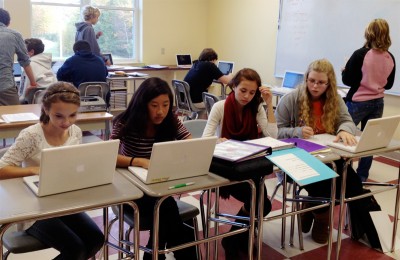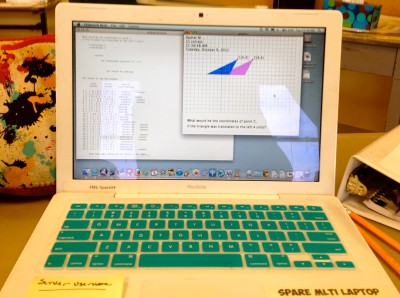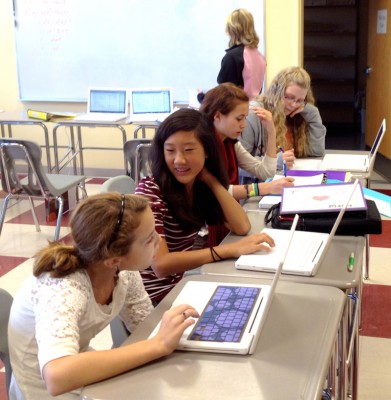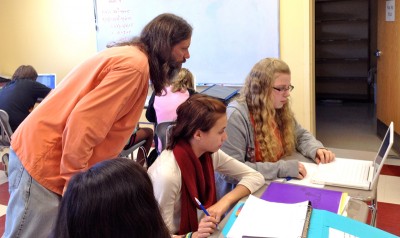Blended Learning, Cost of Education, Domestic, Education Quality, K-12, Legislation, Personalized Learning, Public, Regulatory, Required - Written by Wired Academic on Thursday, November 8, 2012 1:00 - 1 Comment
Maine’s Laptop Program Broadens Students Lives Even If It Doesn’t Boost Their Scores
Freeport Middle School math teacher Alex Briasco-Brin helps students in his eighth-grade algebra class. (Photo by Ricki Morell)
By Ricki Morell
FREEPORT, Maine — At Freeport Middle School, students in algebra class play “Battleship” on their laptops as they learn to plot coordinates on a graph. At Massabesic Middle School, eighth-graders surf the web on their laptops to create their own National History Day websites. And at King Middle School, students carry their laptops into the field as they chronicle the civil rights movement through eyewitness interviews.
These students don’t live in a high-tech mecca like Silicon Valley but in Maine, the nation’s most rural state, where state tax money pays for one white Apple MacBook for every seventh- and eighth-grader in public schools.
More than 10 years ago, Angus King, then Maine’s governor and now a U.S. Senate candidate, pushed the $10- to $11-million-a-year program through a reluctant legislature. King sold it as a way to give the state a competitive edge and provide computers to low-income students. His Republican opponent, Charlie Summers, recently injected the issue into the Senate race when he mentioned the cost of laptops in a broader attack on King’s spending priorities.
Experts say the program has achieved technological equity, but the broader goal of linking laptops to improved student achievement has been more elusive. An August 2011 report, commissioned by the state legislature, concluded that the laptop program “has had a significant impact on curriculum, instruction, and learning in Maine’s middle schools,” but also that it had been carried out unevenly across school districts and subject areas.
“The benefits are difficult to quantify,” says David Silvernail, the report’s author and co-director of the nonpartisan Maine Education Policy Research Institute. “So many other things are going on in schools, it’s difficult to classify what makes the difference. The laptop is a tool, just like a pencil.”
Maine’s 29,000 seventh- and eighth-graders use the laptops during class and take them home at night and on weekends. The laptops have Internet access and can be used for writing, research, communication, homework practice or simply surfing the web. Students are responsible for keeping them charged and in good working order. “It’s my baby,” says seventh-grader Jacob Gregoire at Massabesic Middle School in East Waterboro. “It’s so much better than going to the computer lab.”
Teachers in grades 7-12 also get their own laptops under the program, which began in September 2002. Under a contract with Apple, the state pays a discounted rate of $242 per laptop per year, which includes software, training, technical support and repair. That adds up to about $10 million this year, and about $11 million in previous years—or less than half a percent of the state’s $2 billion education budget. The plan lets high schools buy laptops using local property tax money. The Maine Department of Education’s learning technology director Jeff Mao said 68 of Maine’s 119 high schools chose to participate this school year.
Raymond Grogan, principal of Freeport Middle School in Freeport, was a teacher when the program first started. He says that laptops in the classrooms have helped teachers stop lecturing and start tailoring lessons to individual students. “From a teaching perspective, it changed everything,” he says. “It revolutionized the classroom.”
Educators say problems with the laptops generally fall into two categories: distraction from unrestricted access to the Internet, and laptop breakage and technical glitches. The breakage problems have decreased as students have grown used to taking care of the laptops, Mao says. In addition, a new generation of laptops is stronger and the cases are more protective. The distraction comes when kids look at inappropriate websites when they’re supposed to be working, or more commonly, sneak time on Facebook or YouTube instead of studying. At first, Mao said, schools tried to limit Internet access, but now they’ve found more success by educating parents and students about the Internet through Common Sense Media, a national nonprofit that helps educate children about the media.
“The basic philosophy is not being connected doesn’t make the situation any better,” says Mao. “We need to teach responsibility.”
King says he came up with the idea for the laptop initiative in 1999, after a conversation with technology guru Seymour Papert, a founder of the MIT Media Lab. At the time, Maine had a budget surplus of $70 million. King had been thinking about bridging “the digital divide” as a key to state’s economic development, but he wasn’t convinced that handing out laptops to teenagers was the best approach. He remembers Papert telling him that adding a few computers to schools wouldn’t do much. “It is only in the one-to-one that the power occurs,” he says Papert told him.
 Students in Freeport Middle School’s eighth-grade algebra class taught by Alex Briasco-Brin use laptops to graph polynomials. (Photo by Ricki Morell)
Students in Freeport Middle School’s eighth-grade algebra class taught by Alex Briasco-Brin use laptops to graph polynomials. (Photo by Ricki Morell)It was not an easy sell. From educators to ordinary citizens, people thought it would be a waste of money. “It was not popular at all,” recalls Bette Manchester, the first director of the laptop program and now president of the Maine International Center for Digital Learning in Lewiston. “People thought the money would be better spent on fixing a lot of broken buildings.”
King, who is running as an independent for Republican Olympia Snowe’s U.S. Senate seat, now counts the laptop program as one of his central achievements as governor. He says he never promised higher test scores; he wanted to connect Maine students to the world. “Teachers tell me, ‘I thought you were out of your mind when you first proposed this, but now I can’t imagine teaching without it,’ ” King says.
Summers didn’t return messages left with his campaign asking for comment about his assessment of the laptop program. The state legislature will consider renewing funding in January, the third funding renewal since the program began. State Rep. David Richardson and State Sen. Brian Langley, Republicans who chair the House and Senate education committees, respectively, say they don’t anticipate a fight over funding because the program has become so much a part of the educational landscape.
“Putting all the partisan stuff aside, at the time when this was introduced it was highly controversial, spending all that money,” says Langley, a retired educator who taught culinary arts for 27 years at Hancock County Technical Center in Ellsworth. “But having students in rural Maine be able to have access to the world has been tremendous. I think that is probably Angus King’s legacy.”
Maine’s program inspired other state-funded programs in Michigan, Pennsylvania and South Dakota. But those states abandoned their programs when they ran into politics or tight budgets. At the same time, Idaho and Alabama are moving toward state-funded programs. In a study last year, the One-to-One Institute in Mason, Mich., a national nonprofit that advises school districts about technology programs, found that 2,000 sites nationwide—either entire schools or entire grades within schools—have laptop programs.
In Texas, a four-year study of how laptops affect student achievement showed mixed results. Beginning in 2004, the nonprofit Texas Center for Educational Research compared the test scores of students at 22 Texas middle schools where students and teachers received laptops with the scores of students at 22 middle schools where they did not. The study concluded that laptops had a positive effect on some math scores but generally not on reading scores.
 Close-up of laptop in Freeport Middle School algebra teacher Alex Briasco-Brin’s class. (Photo by Ricki Morell)
Close-up of laptop in Freeport Middle School algebra teacher Alex Briasco-Brin’s class. (Photo by Ricki Morell)In Maine, statewide evidence of how laptops affect achievement is scarce. Test scores for Maine from the National Assessment of Educational Progress, known as the Nation’s Report Card, show that the percentage of students scoring proficient or above in eighth-grade mathematics rose from 30 percent in 2000 to 39 percent in 2011, but that was part of a national trend of rising math scores and can’t be linked directly to laptop use. Between 2002 and 2011, the percentage of Maine’s eighth-graders scoring at or above proficient on the national reading test barely changed, rising from 38 to 39 percent.
Silvernail’s report used online surveys to get general impressions, and gauged achievement through small research studies in math, science and writing. The surveys revealed that Maine’s math teachers use laptops less frequently than teachers of other subjects and that, according to Silvernail, too few teachers use laptops to teach “21st-century skills” such as problem-solving, collaboration and evaluating information.
In math, Silvernail’s team found that test scores were higher in the classrooms where teachers had received special training in integrating laptops into their lessons. In the writing study, researchers linked writing multiple drafts on the computer to a 3-point increase in statewide writing test scores between 2000 and 2005. And in science, they compared two eighth-grade science classrooms—one in which students used laptops to create narrated animations about the angle of the Earth’s axis, and one in which students used traditional paper diagrams. The students who used laptops scored higher on tests given after the unit.
The program’s possibilities are on display every day in three schools with vastly different profiles.
Massabesic is typical rural Maine, with more than its share of students whose families struggle economically. But its seventh-grade science students are exposed to the wider world through the Gulf of Maine Research Institute’s Vital Signs program. Through fieldwork, students study invasive species growing in their area, and then use their laptops to record, analyze and submit their results online to the group’s website. “I’d put my students up against any others in the state in regards to their fieldwork and investigative skills,” says science teacher Patrick Parent.
 Students in Freeport Middle School’s eighth-grade algebra class taught by Alex Briasco-Brin use laptops to graph polynomials. (Photo by Ricki Morell)
Students in Freeport Middle School’s eighth-grade algebra class taught by Alex Briasco-Brin use laptops to graph polynomials. (Photo by Ricki Morell)King Middle School, in downtown Portland, is the state’s most urban school, with a student body that collectively speaks 28 languages. At this school, students participate in interdisciplinary projects combining research and fieldwork, and then create original works such as documentaries. Using laptops, seventh-grade students are now working with Portland arborists to take a computerized tree inventory of their city.
At Freeport Middle School, in a suburban setting a few blocks away from L.L. Bean’s flagship store, math teacher Alex Briasco-Brin decided to create his own online math curriculum that he hopes will instill a deeper appreciation of algebra. Last year, he took a year off from the classroom as a “Distinguished Educator of Maine” to turn the curriculum into an online math textbook that could be used across the state.
On a recent day in his class, 18 eighth-graders used laptops to work alone or in groups on algebraic equations and graphing. Briasco-Brin did not lecture or write on the blackboard. He just wandered around, keeping kids on task and guiding them toward answers.
“If the state took away our laptops,” he says, “I’d have to find another place to teach.”
This story was produced by The Hechinger Report, a non-profit journalism organization based at Columbia University in New York City and was produced in partnership with the Maine Center for Public Interest Reporting, a nonprofit news service in Hallowell, Maine.
1 Comment
Leave a Reply
Campus Buzz
We welcome Tips & Pitches
Latest WA Original Features
-
“Instreamia” Shakes Loose Moss By Launching Spanish Language Mini-MOOC
-
Jörn Loviscach: A German Math Teaching Sensation Emerges On YouTube & Udacity
-
Open University Enters Battle Of The MOOCs, Launches “FutureLearn”
-
Alvaro Salas As A Case Study In Crowd-Funding An Ivy-League Education
-
Jonathan Mugan: How To Build A Free Computer Within A Computer For Your Child
Paul Glader, Managing Editor
@paulglader
Eleni Glader, Policy Editor
Elbert Chu, Innovation Editor
@elbertchu
Biagio Arobba, Web Developer
@barobba
Contributors:
Michael B. Horn
@michaelbhorn
Derek Reed
@derekreed
Annie Murphy Paul
@AnnieMurphyPaul
Frank Catalano
@FrankCatalano
Ryan Craig
@UniVenturesFund
Jonathan Mugan
@JMugan
Terry Heick
@TeachThought
Alison Anderson
@tedrosececi
Ravi Kumar
@ravinepal

The Pulitzer Prize winning investigation newsroom digs into for-profit education.
-
Most Viewed
- Inside Ashford University: A former staffer talks to WiredAcademic
- Infographic: A History Of Information Organization From Stone-Age To Google
- Davos: 12-Year-Old Pakistani Prodigy Girl Talks About Her Online Learning
- Open University Enters Battle Of The MOOCs, Launches "FutureLearn"
- Pearson Llc + Google Expands LMS Business With "OpenClass" System
-
MARKET INTRADAY SNAPSHOT
- Education & Tech Companies We Follow
| APEI | 40.20 |  -0.17 -0.17 |  -0.42% -0.42% | ||
| APOL | 19.01 |  +0.33 +0.33 |  +1.77% +1.77% | ||
| AAPL | 460.16 |  -6.43 -6.43 |  -1.38% -1.38% | ||
| BPI | 10.74 |  -0.09 -0.09 |  -0.83% -0.83% | ||
| CAST | 0.11 |  +0.01 +0.01 |  +10.00% +10.00% | ||
| CECO | 4.08 |  -0.02 -0.02 |  -0.49% -0.49% | ||
| COCO | 2.40 |  -0.02 -0.02 |  -0.83% -0.83% | ||
| CPLA | 32.03 |  -0.41 -0.41 |  -1.26% -1.26% | ||
| DV | 30.69 |  +0.36 +0.36 |  +1.19% +1.19% | ||
| EDMC | 4.03 |  +0.07 +0.07 |  +1.77% +1.77% | ||
| ESI | 18.34 |  +0.04 +0.04 |  +0.22% +0.22% | ||
| GOOG | 792.89 |  +5.07 +5.07 |  +0.64% +0.64% | ||
| LINC | 6.20 |  +0.06 +0.06 |  +0.98% +0.98% | ||
| LOPE | 25.03 |  +0.36 +0.36 |  +1.46% +1.46% | ||
| PEDH | 0.45 |  0.00 0.00 |  +0.00% +0.00% | ||
| PSO | 18.51 |  -0.27 -0.27 |  -1.44% -1.44% | ||
| SABA | 8.61 |  -0.16 -0.16 |  -1.82% -1.82% | ||
| SCHL | 30.87 |  +0.46 +0.46 |  +1.51% +1.51% | ||
| STRA | 51.95 |  -1.54 -1.54 |  -2.88% -2.88% | ||
| WPO | 414.41 |  +5.35 +5.35 |  +1.31% +1.31% |
Domestic, For-Profit, Gainful Employment, Infographics, Personalized Learning, Private, Public, Required, Universities & Colleges - Jan 31, 2013 6:09 - 0 Comments
Infographic: To Get A Degree Or Not To Get A Degree? Here Is An Answer
More In For-Profit
- Ryan Craig: American Clampdown Forcing Forlorn For-Profit Colleges To Look Abroad
- How For-Profit Colleges Major In Marketing & Fail Education
- Infographic: A Graphical Profile Of Today’s Online College Student
- Infographic: A Comparison Of For-Profits v. Non-Profit Online College Data
- Opinion: How “Shareholder Value” Is Destroying For-Profit, Career Colleges
Cost of Education Domestic Education Quality Ethics For-Profit Friend, Fraud, or Fishy Gainful Employment Graduation Rates Legislation Minorities Opinion Recruitment Regulatory Required Retention Rates Student Loans Universities & Colleges
MOOCs, Required, Technology - Feb 16, 2013 10:04 - 1 Comment
MOOC Monitor: Must Reads This Week
More In Technology
- Infographic: Rise of the MOOCs
- Smart Cities Part II: Why DC Is The Planetary Hub Of Online Learning
- Five Questions: Polling EdTech Startup UnderstoodIt’s Liam Kaufman
- Infographic: The Future of Higher Education
- Anne Collier: Study Shows eBooks Gaining Larger Share & Boosting Overall Reading Habits
Domestic K-12 Parents Reading / Literature Required Technology
Cost of Education, Domestic, Early Childhood Education, Education Quality, Friend, Fraud, or Fishy, Legislation, Minorities, Parents, Public, Required - Feb 18, 2013 4:59 - 0 Comments
Important Early Questions Over Obama’s Early Childhood Program Ambitions
More In Friend, Fraud, or Fishy
- Should For-Profit Companies Manage K-12 Schools? A Skeptical Review
- A Letter To Sen. Tom Harkin About For-Profit Charter Schools
- Ryan Craig: American Clampdown Forcing Forlorn For-Profit Colleges To Look Abroad
- Opinion: The Problem With Deceptive Degree Aggregators In The Search For Online Courses & Degrees
- How For-Profit Colleges Major In Marketing & Fail Education
Domestic Education Quality Ethics For-Profit Friend, Fraud, or Fishy Graduation Rates Minorities Recruitment Required Retention Rates Universities & Colleges



i want to do it like that